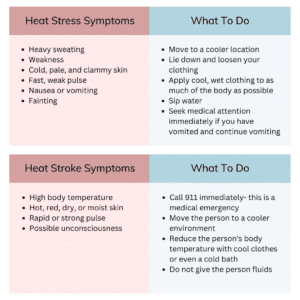As hotter summer weather approaches, raising awareness about heat-related illnesses is essential for worker safety. Heat-related illnesses can be a threat year-round for workers exposed to high-heat environments, commonly observed in manufacturing, construction, and light industrial industries. In summer months, workers in outdoor environments are also especially susceptible to on-the-job heat stress or heat stroke. Occupational heat exposure causes thousands of workers to fall ill every year and, in some cases, can even lead to death. Prevention of heat-related illnesses is the responsibility of both employees and employers.
Companies should provide education and training so employees know how hot working environments can impact their health and, more importantly, how the negative impacts can be potentially avoided. Doherty Staffing Solutions is committed to assisting employers in creating positive and safe work environments for employees. We prioritize safety education for our clients and encourage training for a variety of workplace hazards to help ensure workers have the knowledge they need to perform their work safely.
Being informed about how to protect yourself and your workers in high-heat environments is very important. In this article, we will discuss the dangers of heat-related illnesses, what the signs and symptoms are of these illnesses, and what steps workers can take to prevent this work hazard.
The Dangers of Heat-Related Illness
Heat-related illnesses are dangerous and need to be taken seriously. The prominence of these illnesses is significant for those working in both indoor and outdoor environments that are consistently hot, as they are much more likely to fall victim to heat-related illnesses, such as heat stress or heat stroke. Luckily, heat-related illnesses at work are preventable. These illnesses in outdoor environments often occur because the proper time is not allowed for employees’ bodies to get used to working in this kind of temperature-intense environment. In fact, according to OSHA, 50-70% of heat-related fatalities occur within the first couple of days of working in hot environments because it takes time to develop heat acclimation. If employees are not careful about heat acclimation and using safety precautions, the repercussions can be deadly. A US Bureau of Labor Statistics study found that in the last three decades, more than 900 workers died from extreme heat and tens of thousands more experienced heat-related sickness. Those with underlying illnesses, such as asthma, are especially at risk and will need to take extra precautions to keep themselves safe.
Ultimately, it is crucial that you listen to your body if you begin to feel overheated and pay close attention if you begin feeling ill, as this can be fatal in some situations. Next, we will cover specific things to look out for to ensure your own safety and your workers’ safety, plus determine when heat sickness is an emergency.
Warning Signs & Symptoms
Exposure to extreme heat can have serious health consequences and can result in occupational illness and injury. Heat-related illness includes heat stress, heat stroke, and heat exhaustion, all of which cause unpleasant physical symptoms, such as rashes and cramps. Other physical symptoms from being overheated (sweaty palms, fogged-up glasses, or lightheadedness) can also put workers at risk of injury. Additionally, burn injuries could occur from contact with hot surfaces or steam. Below are signs and symptoms of heat stress and heat illness, as well as what steps to take if you experience either of these heat-related illnesses.
Now that you know the signs and symptoms of heat illness, we will cover how to protect yourself and prevent these hazards.
Protecting Yourself
When it comes to any workplace hazard, prevention is key. Heat-related illnesses are equally as important as other workplace hazards, and employers are responsible for training workers. Hence, they must understand heat-related illnesses, how they affect a person’s health and safety, and how they can be prevented. Employees are responsible for participating in this training and ensuring they are educated enough to recognize key signs and symptoms of heat-related illnesses for themselves and others.
In addition to education, below are other relevant ways to prevent heat-related illnesses at work and keep yourself and others safe, as provided by OSHA.
- Drink cold water before you are thirsty. A good rule of thumb is to hydrate with at least one cup of water every 20 minutes.
- Take breaks. Rest long enough to recover completely, accounting for temperature, humidity, and other environmental factors.
- Find shade or a cooler area. When taking breaks, it is essential to have a designated cooler location to aid recovery.
- Dress for the weather. Wear a hat and loose, breathable clothing when possible.
- Use a buddy system. Monitor both yourself and others for any signs of heat-related illness.
- Change face coverings. If you are required to wear a face covering, make sure to change it if it becomes wet or dirty.
- Monitor for signs of a medical emergency. Signs of an emergency include loss of consciousness, seizures, and/or abnormal behavior or speech. Make sure to stay with any individual experiencing these symptoms until help arrives.
Now that you know the dangers of heat-related illnesses, the common signs and symptoms to watch out for, and what you can do to prevent heat-related illnesses, you can feel well-equipped to avoid this common workplace hazard. With over 40 years of experience in staffing within the light industrial industry, Doherty Staffing Solutions recognizes the importance of workplace safety and the prominence of heat-related illnesses. We make it a priority to educate our employees and workforce so that we can continue to provide a positive and safe working culture.


